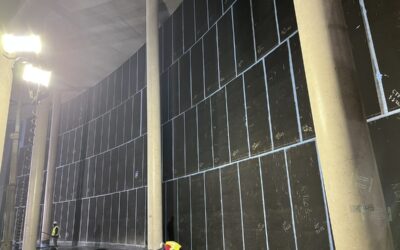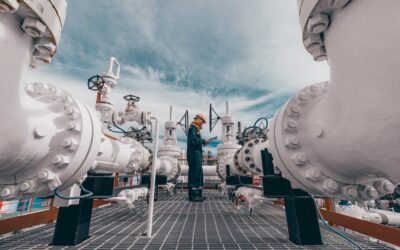Corrosion silently undermines the integrity of industrial tanks, posing a significant threat to their structure. This pervasive issue can result in expensive leaks, contamination, and potentially catastrophic failures. For industries relying on these vessels to store chemicals, fuel, or water, ensuring longevity and safety extends beyond routine maintenance—it demands intelligent protection strategies. Introducing rubber linings: the steadfast shield against corrosion’s destructive effects.
Rubber linings serve as an indispensable ally for your tanks. Learn why countless industries turn to this time-tested solution to preserve their assets and maintain operational excellence. With rubber linings, you can rest assured that your storage solutions stand resilient against corrosive attacks, safeguarding your resources and your peace of mind.
Understanding Corrosion in Industrial Tanks
Corrosion is a natural process that deteriorates materials over time due to chemical or electrochemical reactions with the environment. For industrial tanks, corrosion can lead to structural weaknesses, leaks, and even catastrophic failures, posing serious risks to both safety and productivity.
Among the common causes of corrosion within industrial settings are exposure to harsh chemicals, fluctuating pH levels, oxygen, and moisture. Such conditions are prevalent in industries ranging from chemical processing to wastewater treatment, making corrosion a persistent concern.
The consequences of corrosion on tank integrity and safety are severe. Corrosion can compromise the structural integrity of the tank, leading to the potential release of harmful substances into the environment. Further, unnoticed corrosion can progress to the point of causing unexpected shutdowns or, worse, accidents that threaten human life and cause significant financial loss.
- Chemical or electrochemical reaction between tank material and surrounding environment
- Leads to deterioration and potential structural failure
- Caused by exposure to harsh substances, moisture, and other corrosive elements
- Results in safety risks, environmental hazards, and economic costs
How Rubber Linings Combat Corrosion
Corrosion poses a persistent challenge in the world of industrial tanks, threatening both the integrity and longevity of these crucial storage vessels. Combatting this insidious force requires a robust defense—and rubber linings stand at the forefront of this battle.
Barrier Protection
One of the essential ways rubber linings shield tanks from corrosion is by offering a seamless barrier. This physical layer acts as a steadfast guard that prevents corrosive substances and moisture from coming into direct contact with the tank walls. The impervious nature of rubber means that the armor it provides is both comprehensive and reliable, ensuring that the underlying structure is safe from the corrosive agents lurking in their contents.
Chemical Resistance Properties
Beyond acting as a mere physical barrier, rubber is chemically inert to a wide array of corrosive materials. It doesn’t react with various acids, alkalis, and salts—substances commonly stored in industrial tanks that can aggressively attack and degrade other materials. The very compound structure of rubber linings is designed to endure and resist these assaults, maintaining its integrity even when exposed to these harsh environments for extended periods.
Flexibility to Withstand Expansion and Contraction
Environmental and operational factors often cause tanks to expand and contract. Rubber linings accommodate these fluctuations with exceptional elasticity, preserving their protective abilities without cracking or becoming brittle. This flexibility is key to maintaining a secure and permanent shield against corrosive forces, safeguarding the tank through many cycles of temperature changes and internal pressure variations.
- Rubber’s impermeability makes it a formidable and enduring barrier against corrosive substances.
- Its chemical inertness equips rubber with the ability to resist a vast array of industrial chemicals.
- The inherent elastic properties of rubber allow it to absorb and buffer against the stresses caused by tank expansion and contraction.
Maximize Your Tank’s Lifespan: Benefits of Rubber Linings for Corrosion Protection
Industrial tanks face a constant threat from corrosion, but rubber tank linings offer a robust defense, prolonging tank lifespans and preserving integrity. These linings act as a crucial barrier, shielding tank materials from corrosive substances. Their resilience and tight adherence to tank surfaces provide a customized fit that enhances protection.
Key Features of Rubber Linings That Make Them Effective Against Corrosion
- Chemical resistance: Rubber linings boast excellent resistance to a wide range of chemicals, ensuring that they can withstand harsh environments without degrading.
- Flexibility and elasticity: The inherent flexibility of rubber allows it to absorb mechanical shocks and adapt to temperature-induced expansions or contractions of the tank.
- Durability and longevity: Engineered to endure, rubber linings can significantly outlast other materials when it comes to protecting tanks from corrosive damage.
Advantages of Using Rubber Linings for Corrosion Protection
- Cost-effectiveness compared to alternative solutions: When evaluated over their lifespan, rubber linings are a financially savvy choice, thanks to their durability and low need for replacement.
- Ease of installation and maintenance: The installation process for rubber linings is straightforward, and maintenance requirements are minimal, reducing the overall workload for operational staff.
- Compatibility with various types of tanks and substances: Versatility is a hallmark of rubber linings, as they are compatible with a multitude of tank designs and can handle diverse substances, from water to aggressive chemicals.
What to Consider When Selecting Rubber Linings for Corrosion Protection
When it comes to safeguarding your industrial tanks from the destructive forces of corrosion, choosing the right rubber lining is critical. There are several variables that can influence the effectiveness and longevity of the rubber linings you select. Understanding these factors ensures that your investment in corrosion protection pays off in the long term.
Assessing the Compatibility with Stored Substances
The type of chemicals or substances stored within your tank should be your primary consideration. Rubber linings must be compatible with the tank contents to prevent degradation, swelling, or delamination that can lead to failure. Each type of rubber material has its own resistance profile, so it’s essential to match the lining material with the substances it will come into contact with.
Evaluating Operating Conditions
Operating conditions within the tank such as temperature, pressure, and duration of exposure to chemicals play a pivotal role in selecting the appropriate rubber lining. High temperatures can affect the elasticity and integrity of the rubber, while fluctuating pressures can cause mechanical stress. Ensuring the lining can withstand your specific operational environment is a must.
Considering Tank Design and Material
The design and construction material of your tank can also influence the choice of rubber lining. The lining must be able to adhere properly and conform to the internal geometry of the tank. Tanks made from materials that expand or contract with temperature changes require linings with similar thermal expansion properties to maintain a cohesive bond.
The Importance of Proper Installation and Maintenance
Proper installation and ongoing maintenance are key to maximizing the service life of rubber linings. Even the most suitable rubber lining can fail prematurely if not installed correctly or if maintenance is neglected. It’s crucial to follow the manufacturer’s guidelines and to schedule regular inspections to identify and address any potential issues before they lead to failures.
- Precise installation to ensure a correct fit and complete coverage
- Regular inspections for early detection of wear and degradation
- Timely repairs to avoid further damage and extend lining lifespan
Taking the time to thoroughly assess these factors can save you from costly downtime and maintenance in the future. Choose wisely and ensure that your rubber linings serve as a resilient barrier against corrosion for years to come.
Secure Your Industry’s Future with Ultimate Corrosion Protection
The importance of investing in durable and effective tank defense solutions like rubber linings extends beyond mere cost savings. It is a matter of ensuring long-term operational efficiency, safeguarding the safety of the workforce, and minimizing environmental impact. Reliable rubber linings represent a forward-thinking approach to industrial challenges, positioning your operations to withstand the tests of time and harsh conditions.
As industries continue to evolve and face ever-growing challenges, the decision to invest in rubber linings is not just a precaution—it’s a strategic move towards a safer, more efficient, and future-proof business. We encourage all industries that grapple with the threats of corrosion to consider rubber linings as their first line of defense. It’s a choice that signifies commitment to excellence and a clear vision for a sustainable industrial future.
- Long-term operational efficiency: rubber linings extend the life of industrial tanks, helping to avoid frequent replacements and costly downtime.
- Enhanced safety: by preventing leaks and structural failures, rubber linings contribute to a safer work environment.
- Sustainable choice: with longer-lasting protection, rubber linings are an environmentally friendly option, reducing waste and the need for frequent maintenance.
The adoption of rubber linings against corrosion is more than just an operational decision; it’s a commitment to preserving the integrity and longevity of your industry’s most critical assets. We strongly advocate for the inclusion of high-quality rubber linings in your corrosion protection strategy, for an unwavering shield against the ravages of time and nature.







